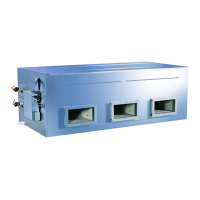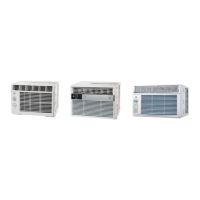M thermal Split
22 202004
Midea M thermal Split
4 Normal Operation Control
4.1 Component Control during Normal Operation
Table 3-4.1: Component control during heating and domestic hot water operations
Component Wiring diagram label
4-16kW
Control functions and states
Inverter compressor
COMP
Controlled according to load requirement from hydronic system
DC fan motor FAN
Controlled according to outdoor heat exchanger pipe temperature
E
valve
EXV
Position (steps) from 0 (fully closed) to 480 (fully open),
to discharge temperature, suction superheat and compressor speed
Four-way valve 4-WAY
On
Table 3-4.2: Component control during cooling operation
Component Wiring diagram label
4-16kW
Control functions and states
Inverter compressor
COMP
Controlled according to load requirement from hydronic system
DC fan motor FAN
Controlled according to outdoor heat exchanger pipe temperature
E
valve
EXV
Position (steps) from 0 (fully closed) to 480
(fully open), controlled according
to discharge temperature, suction superheat and compressor speed
Four-way valve 4-WAY
Off
4.2 Compressor Output Control
The compressor rotation speed is controlled according to the load requirement. Before compressor startup, the M thermal
Split outdoor unit determines the compressor target speed according to outdoor ambient temperature, leaving water set
temperature and actual leaving water temperature and then runs the appropriate compressor startup program. Refer to
Part 3, 3.2 Compressor Startup Program . Once the startup program is complete, the compressor runs at the target
rotation speed.
4.3 Compressor Step Control
The running speed of six-pole compressors in rotations per second (rps) is one third of the frequency (in Hz) of the
electrical input to the compressor motor. The frequency of the electrical input to the compressor motors can be altered at
a rate of 1Hz per second.
4.4 Four-way Valve Control
The four-way valve is used to change the direction of refrigerant flow through the water side heat exchanger in order to
switch between cooling and heating/DHW operations. Refer to Part 2, 3 Refrigerant Flow Diagrams . During heating and
DHW operations, the four-way valve is on; during cooling and defrosting operations, the four-way valve is off.
4.5 Electronic Expansion Valve Control
The position of the electronic expansion valve (EXV) is controlled in steps from 0 (fully closed) to 480 (fully open).
At power-on:
The EXV first closes fully, then moves to the standby position. After a few seconds the EXV moves to an initial
running position, which is determined according to operating mode and outdoor ambient temperature. After a
further a few minutes, the EXV is controlled according to suction superheat and discharge temperature. Once a
further a few minutes have elapsed, the EXV is then controlled according to suction superheat, discharge
temperature and compressor speed.
When the outdoor unit is in standby:
The EXV is at standby position.
When the outdoor unit stops:
The EXV first closes fully, then moves to the standby position.
Midea CAC

